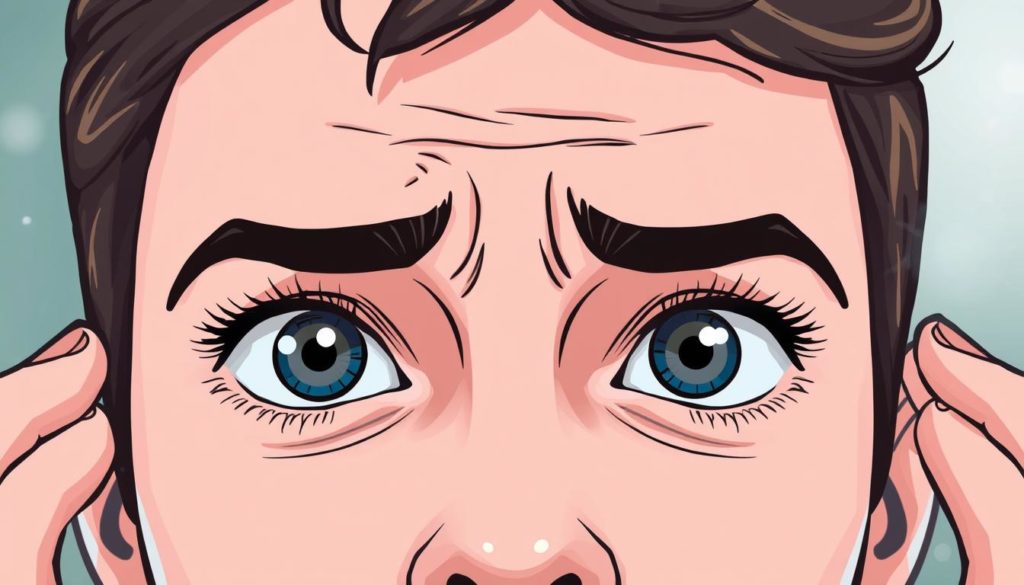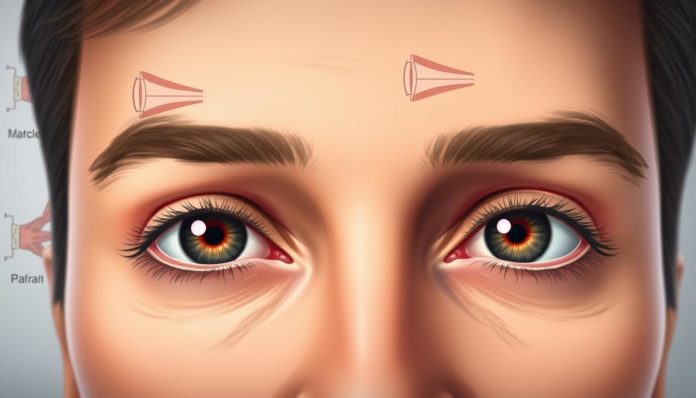Did you know about 4% of people in the US have eyes that naturally drift outward? This is called exophoria. It can make reading and focusing on close objects hard. Knowing about exophoria helps keep our eyes aligned and our vision sharp.
So, what is exophoria, and how is it different from other eye problems? Learning about exophoria helps us understand its impact on our eyes. This article will cover the basics, symptoms, causes, and how to diagnose and treat it. Let’s learn more about exophoria and why keeping our eyes aligned is key.
What Is Exophoria?
Exophoria is an eye condition where one eye looks outward when both eyes are covered. It’s a type of binocular misalignment. People often don’t notice it until they cover one eye.

Exophoria Definition
Exophoria makes one eye move outward from the nose when vision is broken. This is different from other eye problems. The eye usually looks straight when both eyes are open. But, it moves outward when vision is interrupted.
Knowing the signs of exophoria, like trouble focusing and eye strain, is key. It helps doctors diagnose and treat the condition.
How Exophoria Differs from Other Eye Conditions
Exophoria is different from other eye issues in several ways:
- Esophoria: Here, the eye moves inward towards the nose when vision is broken.
- Exotropia: Unlike exophoria, exotropia is always visible, even when eyes are working together.
- Esotropia: This is a constant inward eye movement, seen even with both eyes open.
Knowing how these eye movements differ helps doctors diagnose and treat eye problems. It’s important for effective treatment.
Common Exophoria Symptoms
Knowing the signs of exophoria is key for early treatment. People often see symptoms that affect their daily life. It’s important to spot and treat these signs quickly.

Identifying Early Symptoms
The first signs of exophoria can be small and easy to miss. Eye strain, especially after reading or screen time, is common. Headaches, trouble focusing, and seeing double are also signs.
Some people find it hard to keep their place while reading. They might see things blurry. These issues can make reading a challenge.
When to Seek Help
Knowing when to see an eye doctor is important. If you have ongoing vision problems, headaches, or eye strain, get help. Early treatment can stop the condition from getting worse.
It improves your life quality. Don’t wait to get your vision checked if you’re experiencing these issues.
Potential Exophoria Causes
Understanding what causes exophoria is key to preventing and treating it. The main causes are genetic and environmental factors. Research has found patterns in strabismus causes and eye health.
Genetic Factors
Exophoria can be inherited, showing it runs in families. Studies show people with a family history of eye problems are more likely to have it. Genes linked to eye muscle and nerve development are important.
Environmental Influences
Environmental factors also affect eye health. Too much screen time can lead to eye problems, including exophoria. Poor lighting during focused activities can also strain eyes, making exophoria worse.
Genetics set the stage, but environment plays a big role too. A mix of genetic and lifestyle factors is needed for good eye health.
Methods for Exophoria Diagnosis
Diagnosing exophoria involves several tests and advanced technologies. Each step is designed to give a precise diagnosis. This ensures the best vision assessment and accurate eye exam for confirming exophoria.
Clinical Examinations
Clinical exams are the first step in diagnosing exophoria. Optometrists often use the cover-uncover test. This test covers one eye and observes the other’s movement. If the uncovered eye drifts outward, it shows exophoria.
Another key test is the Maddox rod test. It uses a lens with lines to check for eye misalignment. The patient sees the lines in a certain way, helping to spot any issues.
Diagnostic Technology
Advanced technology also plays a big role in diagnosing exophoria. Tools like computerized retinal imaging and optical coherence tomography give detailed eye images. These technologies help eye care professionals understand the extent of exophoria better.
They can then create a treatment plan tailored to the patient’s needs. This ensures accurate diagnosis and effective treatment.
| Method | Purpose |
|---|---|
| Cover-Uncover Test | Identify eye drift |
| Maddox Rod Test | Check for misalignment based on visual appearance of lines |
| Computerized Retinal Imaging | Provide detailed retina images |
| Optical Coherence Tomography | Detailed structural analysis of the eye |
Using these different methods makes diagnosing exophoria more accurate. It ensures people get the best care possible. From classic tests to advanced imaging, these tools help create a thorough vision assessment process.
Exophoria Treatment Options
There are many ways to treat Exophoria, each one fitting the needs of the person. Eye patching is a common method. It works by covering the stronger eye, making the weaker eye work harder. This helps the eyes line up better over time.
Vision therapy is another effective option. It’s a program of exercises to strengthen eye muscles and improve focusing. These exercises can be done with a professional or at home with the right guidance.
Some people use Exophoria correction lenses to help their eyes align. These lenses reduce eye strain. In very serious cases, surgery might be needed. But, doctors usually try other methods first.
- Eye Patching
- Vision Therapy
- Exophoria Correction with Lenses
- Surgical Options
Exophoria Exercises for Vision Improvement
Doing specific eye exercises can help manage Exophoria symptoms. These exercises strengthen eye muscles and improve coordination.
Eye Muscle Strengthening Exercises
It’s key to do eye muscle exercises to improve alignment and reduce Exophoria symptoms. These exercises boost eye control and focus.
- Convergence Exercises: Focus on a near object, like a pen, and slowly move it closer to your nose while keeping focus.
- Pencil Pushups: Hold a pencil in front of your nose, focusing on the tip as you move it back and forth.
Exercises to Perform at Home
Adding vision exercises to your daily routine at home is easy and important. These exercises need little equipment and can be done often to keep eyes aligned.
- Focus Shifting: Switch your focus between near and far objects to increase eye flexibility.
- Barrel Cards: Use special cards to practice convergence by bringing them closer to your nose.
In summary, adding these eye exercises to your routine can greatly improve eye alignment. This makes it easy to enhance your vision from home.
Professional Treatments for Exophoria
Exercises are not the only solution for exophoria. Professional treatments like optometric vision therapy and surgery are also effective. These treatments are made to fit each person’s needs, aiming to improve eye alignment and vision.
Optometric Treatments
Optometric vision therapy is a personalized program with controlled visual tasks. It helps improve eye coordination, focusing, and tracking. Orthoptics uses exercises and activities under an eye care professional’s guidance to strengthen eye muscles and enhance binocular vision.
In some cases, prismatic lenses are prescribed to help with eye alignment and symptoms.
Surgical Options
For severe exophoria, strabismus surgery might be an option. This surgery repositions the eye muscles to correct alignment. An experienced ophthalmologist performs the procedure to improve eye function and appearance.
The surgery’s outcomes include better eye alignment, improved vision, and reduced or eliminated double vision.
Daily Habits to Improve Exophoria
Adding small but important healthy vision habits to your daily life can greatly help with Exophoria. Simple lifestyle changes can make a big difference in easing eye strain.
One key habit is taking breaks from screens. Try the 20-20-20 rule: look at something 20 feet away for 20 seconds every 20 minutes. This can really reduce eye strain. Also, using the right lighting in your workspace can cut down glare and eye strain.
Here are some tips to support your eye health:
- Adjust Screen Position: Make sure your computer screen is at eye level and 20-24 inches from your eyes.
- Lighting: Use adjustable lighting to avoid glare and reflection on your screen.
- Blinking: Remember to blink often when looking at screens. It helps keep your eyes moist.
- Regular Breaks: Follow the 20-20-20 rule for regular eye rest.
- Hydration: Drinking lots of water helps keep your eyes moist.
By adding these healthy vision habits to your daily routine, you can reduce eye strain and improve eye health. These lifestyle changes not only help with Exophoria but also boost your overall well-being.
Understanding the Difference: Exophoria vs Exotropia
Exophoria and exotropia are often mixed up because they both deal with eye alignment. But they are different binocular vision disorders. Knowing the details of these conditions helps in accurately diagnosing and treating them.
Key Definitions
Exophoria is when one eye tends to drift outward when tired or focusing on something close. But this doesn’t happen all the time. Exotropia, however, is a more serious issue where the eyes are always misaligned. This makes it obvious and often needs more serious treatment.
Comparing Symptoms and Treatments
Exophoria symptoms include occasional double vision, eye strain, or trouble with near tasks, especially when tired. Exotropia, on the other hand, shows constant eye misalignment and more frequent double vision. Treatment for exophoria might include eye exercises and glasses. But exotropia might need surgery and other visual therapies.
Understanding the difference between exophoria and exotropia helps both individuals and healthcare professionals. It ensures the right treatment for each condition is given.
FAQ
What exactly is Exophoria?
Exophoria is when one or both eyes tend to look outward. It’s more noticeable when focusing on something or when vision isn’t working together.
How is Exophoria different from Exotropia?
Exophoria is a condition where eyes drift outward but can align with effort. Exotropia is when eyes are always turned outward, showing a clear misalignment.
What are common symptoms of Exophoria?
Symptoms include eye strain, headaches, and double vision. You might also have trouble focusing or reading. These problems can get worse if not treated.
What causes Exophoria?
It can be due to genes or environmental factors. Too much screen time and poor lighting can also play a part.
How is Exophoria diagnosed?
Doctors use tests like cover-uncover tests and Maddox rod tests. They might also use advanced imaging. These help check how well eyes work together.
What treatment options are available for Exophoria?
Treatments include glasses, eye patches, vision therapy, and sometimes surgery. The right treatment depends on how severe it is and what you need.
Are there exercises to help improve Exophoria?
Yes, there are exercises to strengthen eye muscles. Pencil pushups and convergence exercises can be done at home.
What professional treatments are available for Exophoria?
Professional treatments include vision therapy and prismatic lenses. Orthoptic therapy and surgery might also be options, depending on the case.
Can daily habits impact Exophoria?
Yes, they can. Good habits like taking breaks from screens and ensuring proper lighting can help manage Exophoria.
What’s the difference between Exophoria and Exotropia?
Exophoria is a condition where eyes drift outward but can align with effort. Exotropia is when eyes are always turned outward, showing a clear misalignment. Their treatments and management strategies also differ significantly.


